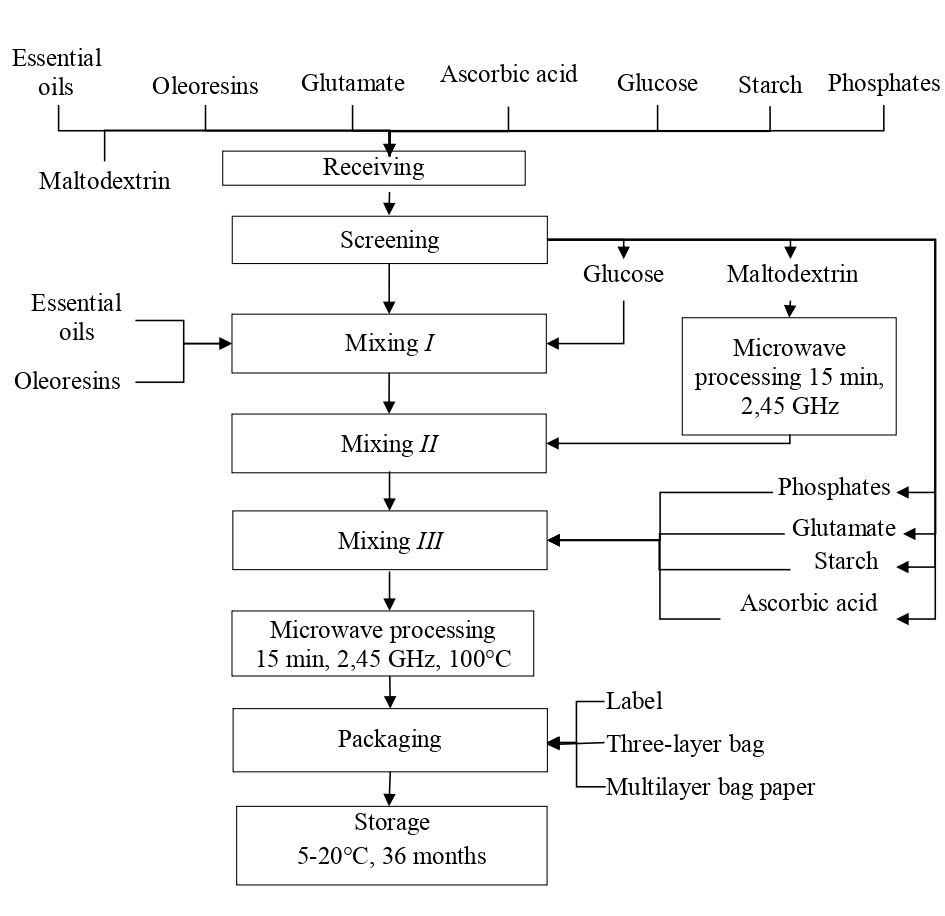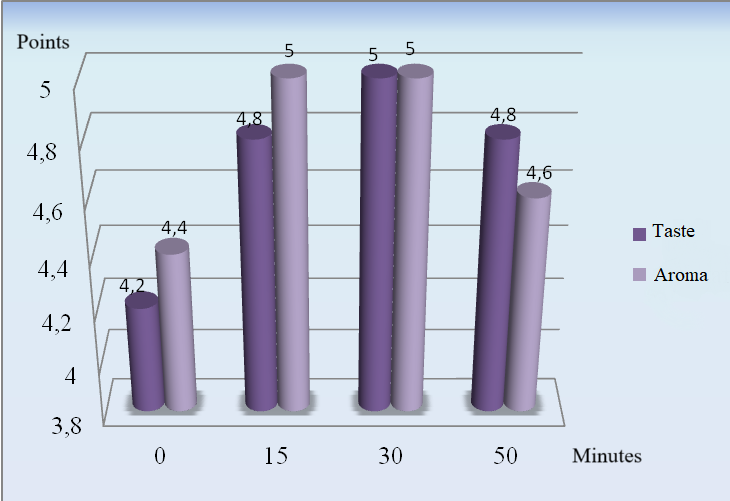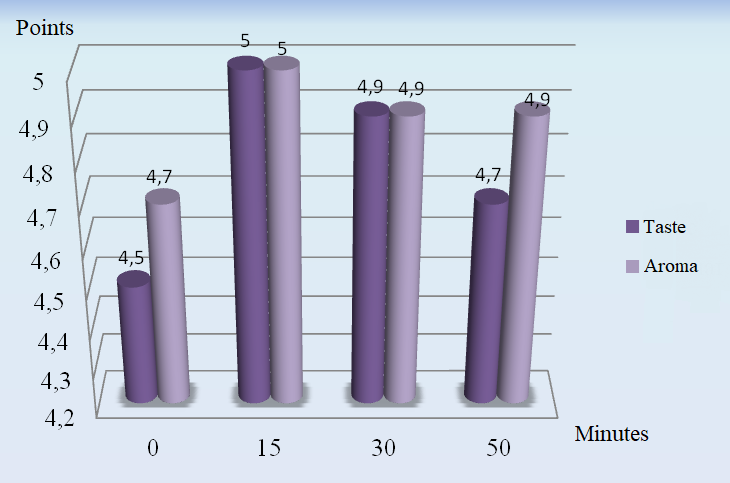Использование микроволнового излучения в технологии производства вкусовых добавок
Использование микроволнового излучения в технологии производства вкусовых добавок
Аннотация
В статье обосновывается эффективность использования микроволнового излучения в технологии производства вкусовых добавок. Разработка выполнена сотрудниками ООО «Специо» в сотрудничестве с профильными научными организациями: Волгоградским государственным техническим университетом (ВолгГТУ), Поволжским научно-исследовательским институтом по производству и переработке мясной и молочной продукции (ГНУ НИИММП), Всероссийским научно-исследовательским институтом пищевых добавок. Описан механизм воздействия радиации на носитель ароматических веществ – мальтодекстрин, основанный на разрушении α- (1→4) и α- (1→6) связей глюкопиранозилов. Рассмотрена технология получения добавок, включающая стадии микроволнового облучения. Техническими результатами обработки являются обеззараживание, повышение текучести, снижение спекаемости, улучшение органолептических свойств. Определены содержание влаги, углеводный состав, декстрозный эквивалент в мальтодекстрине и вкусовых добавках до и после СВЧ-обработки. Также в мальтодекстрине определяли количество мезофильных аэробных и факультативно-анаэробных микроорганизмов (QMAFAnM). Сотрудники профильных научных учреждений провели органолептическую оценку продуктов, содержащих вкусоароматические добавки, обработанные по разработанной технологии. Представлено сравнение цен на инновационные добавки с ценами на добавки ведущих европейских производителей. Предложенные технологии применимы в производстве вкусовых добавок для различных отраслей пищевой промышленности.
1. Introduction
The creation of competitive food products of high quality is facilitated by the widespread use of food additives that perform technological functions and improve the organoleptic characteristics of finished products. The volume of the Russian market of food additives in physical terms in 2019 was estimated at 117,248 tons, which amounted to more than 250 billion rubles, of which 64% were imported. In 2020, Russian enterprises produced 53402 tons of complex food additives, which is 6.9% lower compared to 2019. However, for the period from 2014 to 2020, the average annual increase in the production of food ingredients was 18.2%.
The most popular group is flavoring additives. According to market analysis carried out by Global Market Insight, they account for about 27% of all additives used in the production. According to consulting firm Reports And Data, the global food flavoring market was valued at $15.82 billion in 2019 and is expected to reach $21.08 billion by 2027 at a CAGR of 5.2%. Raw materials in demand on the market used as a carrier in the production of flavor additives are maltodextrin and other starch products , , .
A feasibility study of the industry shows that under the current economic conditions, competitiveness in terms of price-quality criterion for the production of food ingredients and flavoring additives should be created based on the following principles:
– close end-to-end cooperation with the relevant scientific organizations of the Russian Federation, including the development of production technologies, the composition of additives, as well as food formulations using them;
– when using foreign innovations: adapting them to the processing of domestic natural raw materials, energy resources, infrastructure and logistics;
– the use of modern efficient processes, such as extrusion, baro-membrane processes (BMP), ultrasonic (US) and infrared (IR) processing of raw materials, and the creation of unified flexible technological lines based on them , , ;
– introduction of specialized technologies that allow increasing the shelf life of products while maintaining their quality , , .
The basic principles characteristic of the industry in question are reflected in the study. Microwave processing is a modern, efficient process that promotes deeper processing of food raw materials, as well as increasing the shelf life of products. Qualitative improvement of flavoring additives by increasing their flowability, solubility, reducing caking and the dosage of application to food products leads to an extension of the active phase of the life cycle of an additive containing starch modification products in its composition. The developments were carried out with the involvement of employees of specialized higher educational institutions and scientific organizations of the Russian Federation.
In accordance with the information provided on the relevance of the research topic, the following purpose was formulated: to experimentally substantiate the effectiveness of using microwave radiation to modify flavor additives.
2. Materials and methods
The studies were carried out on the basis of the Spezio LLC enterprise in cooperation with such specialized scientific organizations as the Volgograd State Technical University (VolgSTU), the Volga Region Research Institute for the Production and Processing of Meat and Dairy Products (SNU NIIMMP), the All-Russian Research Institute of Food Additives. In the course of studying the effect of microwave radiation on the properties of flavoring additives, several technologies for modifying these additives have been developed, one of which has been patented .
The objects of the study were maltodextrin and flavor additives. When determining their carbohydrate composition, the chromatographic method was used. QMAFAnM (Quantity of Mesophilic Aerobic and Facultative Anaerobic Microorganisms) in maltodextrin and flavor additives was determined before and after microwave treatment by inoculation in agar nutrient media in accordance with GOST 10444.15-94. The granulometric composition of additives was determined by sieving them through sieves with a mesh size of 50, 20 and 10 µm. Analysis of the moisture content in maltodextrin samples was performed by drying the samples to constant weight in an oven. The evaluation of organoleptic indicators of food products samples produced using modified flavoring additives was carried out on a five-point scale with the involvement of specialists from specialized research institutes.
3. Results and discussion
In the course of research, the employees of the Spezio LLC company developed a technology for the manufacture of flavoring additives, including the stages of microwave irradiation. An example of the implementation of this technology is presented in the technological diagram in Figure 1.
After receiving, sifting and weighing, the ingredients enter the mixer, where the mixing process is carried out in stages. In the case of the production of the flavor additive considered as an example using innovative technology, the first step is the introduction of glucose and the injection of liquid ingredients such as essential oils and oleoresins.
In the manufacture of flavor additives, in the production of which liquid components are used, mixers are used that contain liquid injectors in their design. If only dry components are mixed, injectors aren't required. The scheme shown in Figure 1 reflects the technological process for the production of additives, in the manufacture of which, among other things, liquid components are used.
At the second stage, maltodextrins, previously prepared in accordance with innovative technology, are introduced into the mixer. The pretreatment process is the treatment of maltodextrins with microwave radiation for 15 minutes at a frequency of 2.45 GHz. These conditions are optimal for activation and breaking of α- (1→6) and α- (1→4) bonds. An increase in the molecular mobility of the system upon heating leads to a partial decomposition of the granules.
As a result of the implementation of the preliminary preparation of the components in accordance with the presented technological parameters, both the molecular structure and the granules of maltodextrins change, which leads to an increase in flowability and a decrease in caking. The increase in the surface area of maltodextrins that accompanies these changes contributes to a more uniform distribution of flavoring substances and a decrease in the dosage of additives in food formulations. In a microwave dryer, not only maltodextrin is processed, but also starch or other starch products, if this is provided for by the recipe and production technology of a particular additive.

Figure 1 - Technological diagram of the production of flavoring additives
After mixing, the prepared semi-finished product, in accordance with innovative technology, goes from the mixer to the microwave dryer. Reprocessing is necessary to decontaminate the product and prolong its shelf life. Microwave processing is carried out at a radiation frequency of 2.45 GHz until a product temperature of 100oC is reached. Processing with microwave radiation leads to decontamination of the product, and also contributes to further changes in the molecular structure of maltodextrins and deeper dextrinization.
The product is unloaded from the microwave dryer, cooled to 20-25oC and packaged. Packaged products are stored at temperatures from 5oС to 20oС and relative humidity of 75% for up to 36 months. Extended storage periods up to three years are possible due to effective decontamination of products during microwave processing.
It is permissible to produce, in accordance with the presented innovative technology, flavoring additives of a different quality composition, including those involving mixing only dry components. The technique, including microwave processing, is universal, that is, applicable in all technologies, including dextrinization, as one of the technological processes.
As options for implementing innovative technology, it is possible to process only raw materials for its dextrinization or only finished products for dextrinization of starch products contained in it and decontamination of the mixture. However, the maximum effect is achievable by combining the methods of irradiation, as indicated in the diagram presented in Figure 1.
Employees of Spezio LLC developed production conditions for 27 groups of complex flavouring additives. The technology of manufacturing provides microwave radiation treatment at different stages of technological process. According to proposed technologies for each additive, optimal time of irradiation and frequency as well as place in technological process (treatment of maltodextrin or starch before mixing, product before packing) are selected which provides the best organoleptic and technological characteristics of each product.
Maltodextrin DE10 was tested. Microwave processing was carried out at a frequency of 2.45 GHz and a power of 100 W. The results of the study of QMAFAnM, mass fraction of moisture, carbohydrate composition of maltodextrin before and after microwave exposure for various times are presented in Table 1.
Table 1 - Results of testing of maltodextrin
Indicator | Value | |||
Processing time, min. | 0 | 15 | 30 | 50 |
QMAFAnM, CFU / g | 9000 ± 100 | 0 | 0 | 0 |
Moisture content, % | 5.8 ± 0.04 | 4.8 ± 0.04 | 4.0 ± 0.07 | 3.7 ± 0.09 |
Dextrose equivalent, % | 12.3 ± 0.06 | 24.5 ± 0.06 | 29.7 ± 0.09 | 32.2 ± 0.10 |
Higher sugars, % | 93.7 ± 0.04 | 79.9 ± 0.05 | 64.2 ± 0.06 | 58.2 ± 0.11 |
Triose, % | 4.2 ± 0.05 | 10.4 ± 0.05 | 18.3 ± 0.09 | 21.0 ± 010 |
Maltose, % | 1.9 ± 0.07 | 8.9 ± 0.08 | 15.6 ± 0.11 | 17.5 ± 0.11 |
Glucose, % | 0.2 ± 0.06 | 0.8 ± 0.07 | 1.9 ± 0.09 | 3.3 ± 0.10 |
The impact of microwave radiation on maltodextrin leads to a decrease in QMAFAnM from 9000 CFU / g to zero after 15 minutes of exposure. The dextrose equivalent increases from 12.3 to 24.5, 29.7 and 32.2% at fifteen, thirty and fifty minutes exposure, respectively. The most noticeable changes in dextrose equivalent – more than two times – were noted in the first 15 minutes of treatment. With a fifty-minute treatment, the content of higher sugars is reduced from 93.7 to 58.2%. Reducing the size of the polymer molecules of maltodextrin, which acts as a carrier in flavor mixtures, has a positive effect on the uniform distribution of flavoring substances.
Data on the decrease in moisture as a result of processing characterize technological losses. Despite the fact that the humidity decreases from 5.8 to 3.7% during a fifty-minute treatment, due to the rather low initial moisture content of the product, the absolute value of losses can be considered insignificant.
Flavoring additives Kombimit "Doktorskaya" produced by Spezio LLC and "Sladkie slivki" were studied before and after microwave treatment. Processing was carried out at a frequency of 10 GHz and 2 GHz, respectively, in microwave units with a power of 100 W. The test results are presented in Table 2.
Table 2 - Test results of flavor additives
Indicator | Name of flavor additive | |||||||
Sladkie slivki | Kombimit "Doktorskaya" | |||||||
Processing time, min. | 0 | 15 | 30 | 50 | 0 | 15 | 30 | 50 |
Moisture content, % | 11.8 ± 0.09 | 8.4 ± 0.08 | 6.2 ± 0.08 | 4.9 ± 0.05 | 10.8 ± 0.11 | 6.1 ± 0.08 | 4.3 ± 0.08 | 3.7 ± 0.07 |
QMAFAnM, CFU / g | 50 ± 5 | 0 | 0 | 0 | 105 ± 25 | 0 | 0 | 0 |
Dextrose equivalent, % | 5.5 ± 0.1 | 11.8 ± 0.1 | 15.1 ± 0.08 | 16.8 ± 0.11 | 5.1 ± 0.09 | 11.0 ± 0.05 | 14.1 ± 0.07 | 15.5 ± 0.04 |
Residue on a sieve 50 microns, % | 10 ± 0.1 | 9 ± 0.2 | 9 ± 0.1 | 8 ± 0.2 | 12 ± 0.1 | 10 ± 0.2 | 9 ± 0.1 | 9 ± 0.1 |
Residue on a sieve 20 microns, % | 50 ± 0.1 | 48 ± 0.1 | 47 ± 0.2 | 46 ± 0.1 | 52 ± 0.3 | 50 ± 0.3 | 49 ± 0.2 | 48 ± 0.1 |
Residue on a sieve 10 microns, % | 60 ± 0.3 | 58 ± 0.1 | 57 ± 0.2 | 57 ± 0.1 | 65 ± 0.1 | 63 ± 0.3 | 62 ± 0.3 | 60 ± 0.3 |
Keeping the flavor additives in the microwave for 15 minutes leads to a decrease in QMAFAnM to zero. At the same time, the moisture content of the product decreases from 11.8 to 8.4% and from 10.8 to 6.1% in the case of processing the additives "Sladkie Slivki" and Kombimit "Doktorskaya", respectively. The dextrose equivalent also more than doubles in the first 15 minutes of microwave exposure.
Analysis of the granulometric composition of additives Kombimit "Doktorskaya" and "Sladkie Slivki" shows a decrease in the residue on each of the sieves during the processing time by 2-5%. The decrease in particle size indicates the possibility of a more uniform distribution of flavoring substances in the mixture.
The organoleptic characteristics of modified flavoring additives were evaluated by manufacturing food products containing these additives, followed by their tasting by specialists from specialized scientific institutions. The highest organoleptic evaluation was given to products that included modified flavor additives treated with microwave radiation for 15 or 30 minutes. Diagrams reflecting the results of the organoleptic evaluation of boiled sausage "Doktorskaya" and cupcakes made using the additives Kombimit "Doktorskaya" and "Sladkie slivki" are shown in Figures 2 and 3, respectively.

Figure 2 - Organoleptic evaluation of boiled sausage "Doktorskaya"

Figure 3 - Organoleptic evaluation of cupcakes
Table 3 - Comparative analysis of prices
Name of additive | Manufacturer | Price, rub./kg | |
without processing | with processing * | ||
Kombimit "Doktorskaya" | Spezio LLC | 550 | 585 |
KPD Doktorskaya Kombi 7408 | Almi LLC | 800 | – |
Kombimilk slivki | Spezio LLC | 430 | 450 |
Food Flavoring Slivki 02780 | Frutarom Etol LLC | 450 | – |
Kombikejk Vanil' | Spezio LLC | 460 | 475 |
Food Flavoring Vanil' 02631 | Frutarom Etol LLC | 510 | – |
Kombikejk Mindal' | Spezio LLC | 450 | 465 |
Food Flavoring Mindal' 01324 | Frutarom Etol LLC | 470 | – |
Note: * – for the products of Spezio LLC
4. Conclusion
As a result of the research work, the employees of Spezio LLC, together with specialized scientific organizations, developed innovative technologies for modifying flavor additives, and experimentally substantiated the effectiveness of using microwave radiation in these technologies. The proposed stage of irradiation is carried out before mixing the components or after it.
A decrease in the particle size of maltodextrins was confirmed when they were treated with microwave radiation, including as part of mixtures of complex additives. This factor contributes to an increase in flowability, a decrease in caking, and an intensification of the flavoring qualities of food additives. An increase in the dextrose equivalent with an increase in the exposure time of the samples indicates the effective dextrinization of starch products during their irradiation. Decontamination, which is one of the processing effects, ensures the microbiological purity of food additives and increases their shelf life up to three years. The additives produced by the innovative technology of Spezio LLC compare favorably in price with European analogues, which, along with organoleptic, physicochemical and microbiological advantages, ensures their competitiveness.
